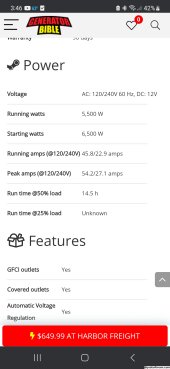I have a renogy 800w solar panel kit with the 3000 w inverter and rover 60a charger; also a handful of 200ah 12v agm batteries.
This is my first winter or fall rather with solar and I am noticing it isn't going to get sustainable. During summer i get to like 100% on the high end, more often than not, and maybe like 65% on a super rare day... well in the past week its been more like 24% highest and maybe 16% on average.. i am aware this is well below the 50% discharge rec. I know there are inverters that are chargers as well or maybe controllers that u can use other things to charge.... forgive my ignorance but I am working with what I have.
Several problems with your current setup. One is the panel angle is probably not close to the sun horizon for winter. Second, the AGM batteries are lead acid technology and will require absorption over a long time period to get fully charged. If you don't hit 100% SOC often, the batteries will sulfate. This leads to decreased capacity, eventually killing the battery. Running below 50% SOC with any lead acid based battery will lead to increased sulfation, eventually killing the battery with accelerated sulfation. In order to reach 100% SOC, the absorption charge is slow due to the increasing resistance of the lead acid type battery as it approaches full charge. This is a problem with reduced hours of sun, you only get X number of hours and are only pulling X number of watts that are declining due to the increasing resistance.
First thing is split up your bank into 2 banks. You will have to use an external charger most likely to get one bank to 100% SOC using an absorption charge. The other bank can be charged off your MPPT while you use it. Most likely though you will find you don't have enough PV.
I just used the search feature to look up some of the posts I had for lead acid batteries using the term AGM. One was this post.
https://diysolarforum.com/threads/renogy-100ah-agm-renogy-100ah-hybrid-gel.62240/post-790120 If I were you, I'd source a LFP battery or 2. Two 100Ah LFP batteries equals two 200Ah lead acid batteries for useable capacity unless you can't store the batteries above freezing and don't have a heating pad. There is a place for lead acid, an example might be a cabin used mainly in summer and occasional use of short periods during winter. When not there, the batteries can achieve 100% SOC with an absorption charge. But still, the 50% discharge rule applies so the bank size might be quite large. LFP doesn't care about partial charge, this is one of the main reasons the big movement to solar systems with battery storage has taken place.
I have a predator 2000 generator/inverter 1600 running watts. If I was to plug the male end of a heavy Guage extention cord into the generator and splice the other end and connect it into the PV- & PV+ of the rover 60a, pretending just as if the current was coming from the panels, would this be a huge mistake? Are there any alterations "off label" that I can do to make this work?
The generator outputs AC current while a charge controller runs on DC. Don't do this.
Using a generator to only charge a battery bank and not run loads is a waste of fuel. The battery bank can only accept X number of watts as 100% SOC is reached. If you want to use the generator, then again, split your batteries into 2 banks and use 2 battery chargers while running loads off the generator. One bank can be in absorption while the other might be just above 50% SOC. Running your loads at the same time allows for efficient use of the fuel.
Thanks for ur time yall
Kindly,
DM



